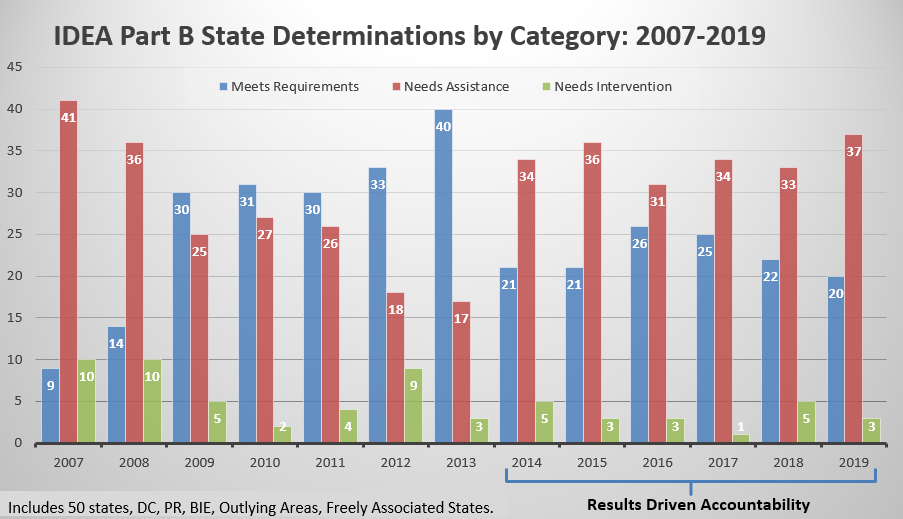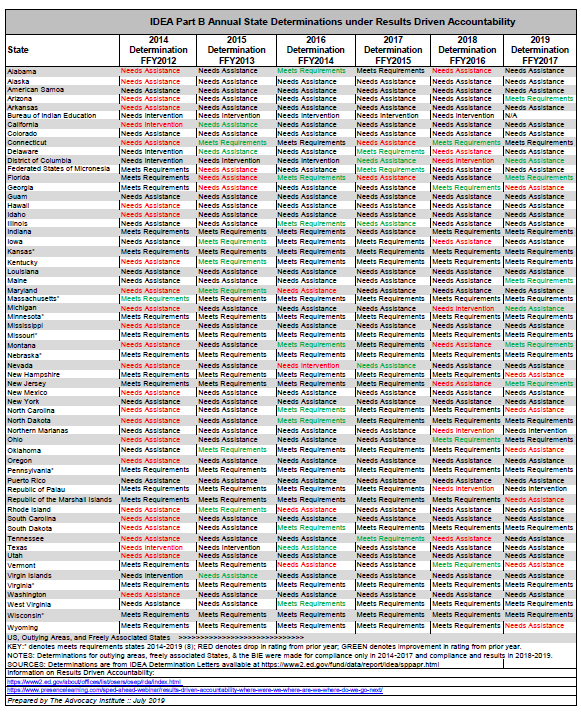Little Improvement in States’ Implementation of IDEA Part B in 2017
June 28, 2019
The U.S. Dept. of Education’s Office of Special Education Programs (OSEP) has released the state determination letters for FFY 2017. These annual determinations are required by IDEA as part of OSEP’s monitoring and enforcement responsibilities. The process for making the annual determinations changed significantly in 2014 when OSEP initiated Results Driven Accountability (RDA) which added several “results” elements in an attempt to raise the achievement of students with disabilities. The RDA process is explained in our November 2018 report, Results Driven Accountability Needs Substantial Intervention.
In the 6 years of state determinations using RDA (2014-2019), states have made little to no progress in improving their ratings. As the chart below clearly shows, this latest round of ratings puts a record number of states in the “Needs Assistance” category at 37 and the lowest number of states in the “Meets Requirements” category at 20.
Some key findings of the 2019 determinations (for FFY 2017):
- Only 8 states have achieved a “Meets Requirements” rating for all of the 6 years under RDA (KS, MA, MN, MO, NE, PA, VA, WI). These states educate just slightly more than 1 million of the nation’s 6.2 million students with disabilities ages 6-21. In other words, just 17 percent of the nation’s students with disabilities are receiving special education services in states that deliver results.
- Most of the states serving the largest numbers of students with disabilities are rated as “Needs Assistance” (CA, IL, NY, TX). These 4 states serve 30 percent of the nation’s students with disabilities.
- From 2018 to 2019:
- Seven states’ rating went down from “Meets Requirements” to “Needs Assistance” (GA, NH, NC, OK, VT, WY and the Marshall Islands).
- Seven states improved their rating from “Needs Intervention” to “Needs Assistance” (DC, MI) or from “Needs Assistance” to “Meets Requirements” (AZ, FL, ME, MT, NJ).
The table below shows the RDA ratings by state. Download the table here (PDF). Details for each state’s determination are available here.
In issuing the 2019 state determinations, OSEP has announced several changes that are being considered for the next round of determinations in 2020.
“The Secretary is considering modifying the factors the Department will use in making its determinations in June 2020 as part of its continuing emphasis on results for children with disabilities. Section 616(a)(2) of the IDEA requires that the primary focus of IDEA monitoring must be on improving educational results and functional outcomes for all children with disabilities, and ensuring that States meet the IDEA program requirements, with an emphasis on those requirements that are most closely related to improving educational results for children with disabilities.
The Part B proposed determinations process will include the same compliance factors as in past years, with one addition. For the 2020 determinations, rather than weighting each compliance factor equally, OSEP is considering assigning greater weight to those compliance factors most directly related to improving results for children with disabilities. For the 2020 determinations process we are also considering, as two additional results factors, State-reported data on: preschool child outcomes and the State Systemic Improvement Plan (SSIP). Using preschool outcomes for Part B determinations is consistent with the use of the early childhood outcomes factor that has been used for Part C determinations since 2015. Use of this factor emphasizes the importance of preschool outcomes in promoting later school success for students with disabilities. The inclusion of the SSIP as a results factor in making determinations would continue OSEP’s emphasis on incorporating a results-driven approach as States identify evidence-based practices that lead to improved outcomes for children and youth with disabilities. In addition, we are considering several changes to the results factors related to the participation and performance of children with disabilities on assessments, including: (1) using Statewide assessment results, rather than the NAEP performance data; (2) looking at year-to-year improvements in Statewide assessment results and taking into account the full Statewide assessment system, including alternate assessments; and (3) no longer comparing each State’s assessment performance with that of other States. Finally, OSEP will be revisiting ways of measuring improvement in the graduation rate of students with disabilities. As we consider changes to how we use the data under these factors in making the Department’s 2020 determinations, OSEP will provide parents, States, entities, LEAs, and other stakeholders with an opportunity to comment and provide input through OSEP’s Leadership Conference in July 2019 and other meetings.”
We are pleased to see that several of the proposed changes will address many (but not all) of the issues put forth in our report, Results Driven Accountability Needs Substantial Intervention, and look forward to receiving more details about the changes as well as an opportunity to provide comments to OSEP.

